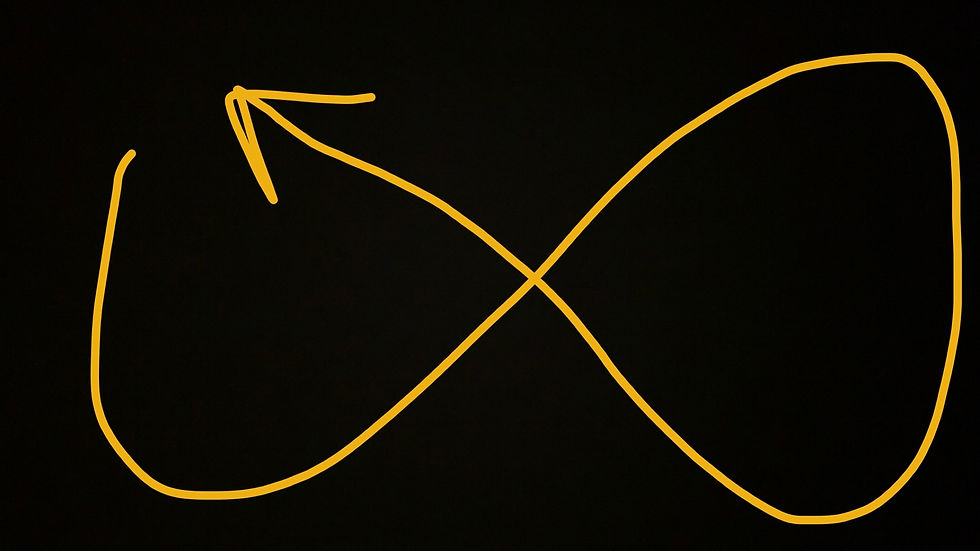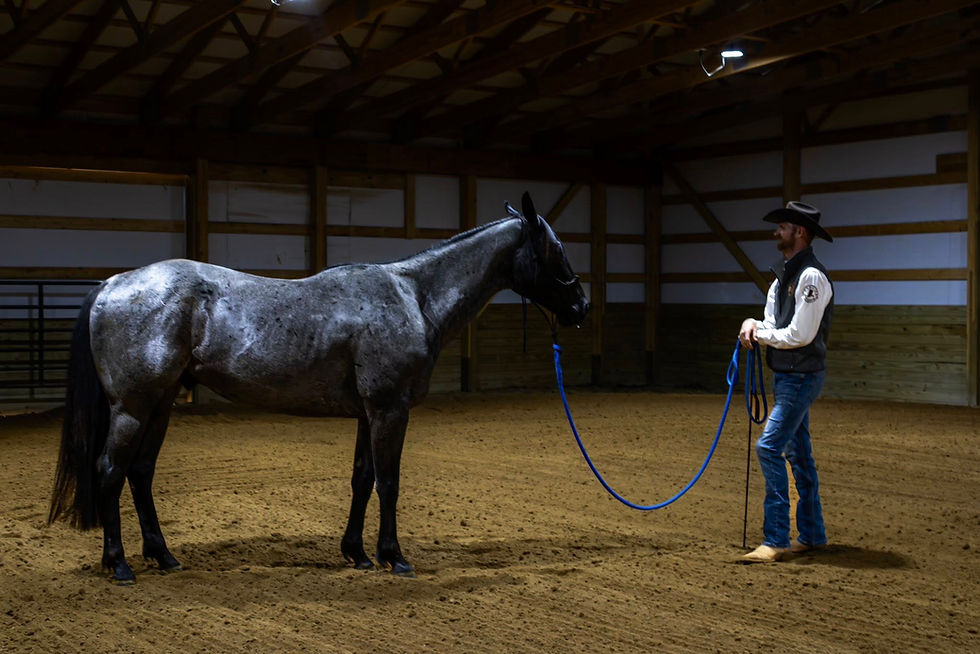My Favorite Flying Lead Change Drill
- Michaela Pemberton

- Sep 9, 2024
- 5 min read
Drill Introduction and Purpose
I learned this drill while attending college and it is my favorite drill to teach a horse to do a controlled flying lead change. A flying lead change is when your horse switches his lead without breaking gait. It is important to teach the horse how to change leads based off your seat and leg. Do not force your horse to change leads by turning quickly. This does nothing to educate the horse and you'll never get the horse to change leads on a straight line by practicing lead changes this way. This drill teaches the horse to move their body laterally off your leg.

In order to learn how to do flying lead changes, first you have to understand the biomechanics of the lope. For the purposes of this article we are going to assume we are loping on the left lead and going to switch to the right lead.
The lope is a three beat gait. When your horse lopes off on the left lead their right hind leg pushes off, the first beat. The right front and left hind will hit the ground together, the second beat. Finally, the left front hits the ground, the third beat. With this being said, you should understand whichever hind leg pushes off indicates which lead your horse will take and that you have to have hip control to truly have control over your horse's leads.
For this drill to be successful for you, your horse must be able to drive up into the bridle and correctly leg yield at the lope. If your horse doesn't do these you will need to work on this first.
The Flying Lead Change Drill
Step 1
To begin the drill you will pick up a lope on the left lead and use half the arena to start loping large circles to the left. While you are loping the circles you're going to drive him up into the bridle. Keep circling until your horse is soft in the face and body.

Step 2
Once your horse is soft you are going to lope across the diagonal of the arena.

Step 3
When you reach the opposite corner of the arena you are going to counter canter half a circle around the end of the arena. Counter cantering can be tricky, especially if your horse knows his correct leads and is uncomfortable being on the incorrect lead for the direction he is traveling. Since he will be on the left lead traveling to the right, you will need to use your right leg to push his hips to the outside of the arena as you circle to keep him on the left lead.
Step 4
Now you will lope across the opposite diagonal of the arena and continue loping your circles to the left.
If steps 1-4 went smoothly for you continue to step 5. If steps 1-4 were difficult or your horse had a break of gait at the counter canter repeat steps 1-4 until they are smooth and correct. This may be all you complete the first day you try this drill.

Step 5
At the beginning of step 5 you should be back to loping your circles that we loped in step 1. Next you are going to lope across the diagonal again. This time you are going to leg yield to the left all the way across. It is important to make sure that you have their hip when leg yielding. Their shoulders, ribs, and hips should be in a straight line and moving to the left.
Step 6
When you reach the corner of the arena you are going to stop leg yielding and begin counter cantering a half circle again like you did in step 3.
Step 7
Lope back across the diagonal and continue your circles to the left.
If steps 1-7 went smoothly continue to step 8. If leg yielding across the diagonal was a struggle for you, or if you did not keep their hip, repeat steps 5-7. This may be all you do the first or second day of this drill. You may even find that your horse doesn't leg yield as well as you thought. You can go back to practicing the leg yield at the trot if need be. Don't forget to make sure their hips aren't getting left behind.
Step 8
If you have reached step 8 then your horse should be able to correctly leg yield across the diagonal of the arena and counter canter while staying soft.
For this step, you are going to repeat step 5. This time we are not going to counter canter. As you approach the corner of the arena while leg yielding you are going to ask your horse to switch leads. While you are leg yielding your right leg should be on your horse pushing him to the left. When you ask your horse to switch you are going to take your right leg off and immediately add your left leg back by his hips to push them to the right. If everything up to this point was done correctly your horse should switch leads while traveling a straight line.

Step 9
If your horse successfully switches leads in both the front and hind, lope a half circle and then across the diagonal. As you go across the diagonal let them dribble down to the walk as a reward for switching their leads. If this is the first time you and your horse have done a flying lead change I would be done for the day and cool them out. Let them know they did a good job.
If your change wasn't successful and they didn't switch their leads at all then you need to go back to practicing your leg yield. Make sure they are soft and responsive moving off your leg. If your horse only switched their front lead and not their hind lead (meaning they are now cross firing) then you did not have enough control of their hip. Go back to practicing your leg yield and make sure their hip isn't getting left behind.
Conclusion
This drill is advanced and your horse has quite a few precursors they must understand for it to be successful. If you and your horse are not quite ready for this drill but have a goal to try it some day, start practicing body control. Practice moving their shoulders, ribs, and hips independently. Try leg yielding at the walk. Practice walking along the rail and pushing their hips to the inside. Once they understand body control at the walk try it at the trot and then the lope.
Make sure your horse is physically in shape enough for this drill. It can be physically demanding because your horse will be using muscles they aren't used to using. Don't over do it and practice parts of it at a time.
Some horses may get hot during this drill. If your horse is getting excited take a step back and try something else and come back to it. It may make them anxious if they don't understand body control. Keep them soft by making sure they fully understand each step before moving onto the next one.
To practice a flying lead change going from the right to the left lead, simply reverse all the left and rights. Only practice one direction at a time. Make sure your horse understands one direction before switching and practicing the other.
The flying lead change drill can be beneficial for you and your horse no matter what discipline you compete in. If you compete in reining this will help you with the lead change maneuver in your pattern. If you barrel race, this will help you with your approach to the second barrel. If you can switch leads between the first and second barrel you will be better set up coming into your pocket. If you compete in horsemanship, your horse will be better prepared if there is a lead change maneuver in your pattern at your next show.
Written by Michaela Pemberton
_PNG.png)



Comments